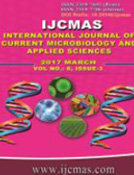


 National Academy of Agricultural Sciences (NAAS)
National Academy of Agricultural Sciences (NAAS)

|
PRINT ISSN : 2319-7692
Online ISSN : 2319-7706 Issues : 12 per year Publisher : Excellent Publishers Email : editorijcmas@gmail.com / submit@ijcmas.com Editor-in-chief: Dr.M.Prakash Index Copernicus ICV 2018: 95.39 NAAS RATING 2020: 5.38 |
Bittergourd is one of the most popular vegetable cultivated throughout India and extensively grown in Kerala. The fruits are used in a variety of culinary preparations and possess high nutritive and medicinal value. The commercial cultivation of bittergourd is very successful because of its high demand and market value. The major constraint faced in the cultivation of bittergourd is the incidence of diseases. Among the various diseases inflicting bittergourd, downy mildew is one of the most serious diseases in the state during the monsoon period leading to heavy economic losses. It is caused by the oomycete Pseudoperonospora cubensis (Berk. and Curt.) Rostow. which is one of the most destructive pathogens of all cucurbits that affects the crop both in the field and those grown in passive or traditional greenhouses. Hence, two research experiments were carried out at the College of Horticulture, Vellanikkara in 2013-14, and two farm trials were laid out in farmer’s field in 2014-15 to study the effect of fungicides and bioagents against downy mildew disease of bittergourd. The research experiment was conducted with ten treatments and three replications. Treatments were applied on symptom appearance. Three sprays were given at 14 days interval except for systemic fungicide (2 sprays) and incidence and severity of the disease were recorded before first spraying and 10 days after each spraying using 0-5 scale for both diseases and per cent disease severity (PDS) was calculated. In this study, the systemic fungicide pyraclostrobin (0.5 gl-1) and the combination fungicide, cymoxanil + mancozeb (2gl-1) having label claim as well as the bioagent, P. fluorescens were found effective and therefore were selected for farm trial experiments. In the farm trial laid out at Vaniayampara, it was noticed that all treatments were found effective than control, recording 13.63 – 19.88 per cent disease severity against 45.5 per cent in control (Table 2). Minimum severity was recorded in pyraclostrobin (0.5gl-1) (13.63%) followed by cymoxanil + mancozeb (2gl-1) (15.13%) and P. fluorescens (2%) (19.88%) and the highest yield was recorded in pyraclostrobin (0.5gl-1) (18.27 kg/cent) followed by P. fluorescens (2%) (17.89 kg/cent).
 |
 |
 |
 |
 |